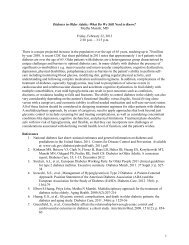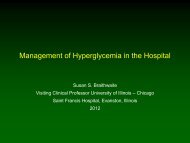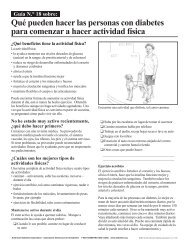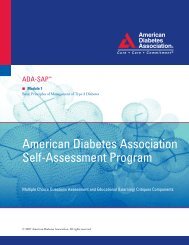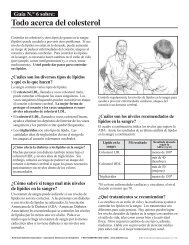Bariatric & Metabolic Surgery: - American Diabetes Association
Bariatric & Metabolic Surgery: - American Diabetes Association
Bariatric & Metabolic Surgery: - American Diabetes Association
Create successful ePaper yourself
Turn your PDF publications into a flip-book with our unique Google optimized e-Paper software.
2/16/2011<strong>Bariatric</strong> & <strong>Metabolic</strong> <strong>Surgery</strong>:A New Paradigm for an Old DiseaseMichael J. Garren, MD, FACSClinical Professor of <strong>Surgery</strong>Medical Director, UW Health <strong>Bariatric</strong> <strong>Surgery</strong> ProgramToday’s Discussion• The Diabesity Epidemic• <strong>Bariatric</strong> <strong>Surgery</strong> – Impressive Results• Is <strong>Diabetes</strong> a Surgical Disease?• Mechanism of <strong>Diabetes</strong> Control• Implications for Future TherapiesWhat’s In a Name?1
2/16/2011Diabesity – An Epidemic• <strong>Diabetes</strong> Mellitus affects more than 150million people worldwide• Expected to double by 2025• Recent data suggest the number of obeseadults is now greater than the number ofoverweight adultsObesity: The Health Crisis in America• Surgeon General, physicians and the <strong>American</strong>public all agree• 66% of <strong>American</strong> adults overweight or obese• 34% are obese• 5% are severely obese• Over 22% of WI adults are obeseTrust for America’s Health Facts 2004,http://www.cdc.gov/pcd/issues/2005/jan/04_0087.htmlHealthcare Costs of Obesity• Obesity has been shown to be associated with:– 36% increase in inpatient and outpatient spending– 77% increase in medication use• Highest-cost drivers are those of managing theco-morbidities associated with obesity– 85% of the total cost of treating type 2 diabetes– 45% of the cost of treating hypertensionRoland Sturm, PhD, Health Affairs, March/April 2002UW2
2/16/2011ClassBMI(kg/m 2 )RiskUnderweight 40 Extremely HighSuper Obesity IV >50 Extremely HighSuper SuperExtremely HighV >60ObesityClinical Guidelines on the Identification, Evaluation, and Treatment of Overweight and Obesity in Adults—The EvidenceReport. Obes Res 1998;6(suppl 2). Extreme often referred to as Clinically Severe Obesity or Morbid Obesity.Morbid ObesityAn “epidemic within an epidemic”Sturm R. Increases in clinically severe obesity in the United States, 1986-2000. JAMA2003;163:214610 million <strong>American</strong>s are morbidly obeseTrust for America’s Health Facts 2004 http://www.cdc.gov/pcd/issues/2005/jan/04_0087.htmPrevalence of Significant Morbidities60%50.90% 52.00%50%44.20%PERCENTAFFLICTED40%30%20%25.60%22.60%10%0%<strong>Diabetes</strong> Asthma Arthritis High BloodPressureCancer death*BMI40Mokdad AH et al. JAMA 2003;289:76 Center for Disease Control, National Center for Health Statistics3
2/16/2011Physiological Impact of ObesityPulmonary diseaseabnormal functionobstructive sleep apneahypoventilation syndromeNonalcoholic fatty liverdiseasesteatosissteatohepatitiscirrhosisGall bladder diseaseGynecologic abnormalitiesabnormal mensesinfertilitypolycystic ovarian syndromeOsteoarthritisSkinIdiopathic intracranialhypertensionStrokeCataractsCoronary heart disease<strong>Diabetes</strong>DyslipidemiaHypertensionSevere pancreatitisCancerbreast, uterus, cervixcolon, esophagus, pancreaskidney, prostatePhlebitisvenous stasisNAASO Obesity Online“Diabesity”• A direct relationship exists between the obesityepidemic and an emerging epidemic of diabetes• In the past two decades, the rate of diabetes hasdoubled in America• <strong>Diabetes</strong> increases the risk for heart disease 6 foldand multiplies the risk of stroke by 4• <strong>Diabetes</strong> is the most costly disease in America,consuming 1 out of every 7 dollarsWhy <strong>Bariatric</strong> <strong>Surgery</strong>?Nonsurgical treatment for those sufferingfrom morbid obesity produce a failurerate near 100%National Institutes of Health. Clinical Guidelines on the Identification, Evaluation, and Treatment ofOverweight and Obesity in Adults—The Evidence Report [published correction appears in Obes Res.1998;6:464]. Obes Res. 1998;6(suppl 2):51S-209S.Jain A. What Works for Obesity? A summary of the research behind obesity intervention. London,England: BMJ Publishing Group; April 20044
Weight change (kg)2/16/2011Very Low Calorie Diet (VLCD)+/- Behavior Modification50-5-10-15Very-low-calorie dietModified diet plusbehavior therapyVery-low-calorie diet plusbehavior therapy-20Intervention 1 2 3 4 5Years after interventionInt J Obes 1989;13 Suppl 2:39-46.Why <strong>Bariatric</strong> <strong>Surgery</strong>?The Cleveland Clinic Center forMedical Art & Photography © 2007.All Rights ReservedNEJM Summary of Results“Effects of <strong>Bariatric</strong> <strong>Surgery</strong> on Mortality in Swedish Obese Subjects,”by Sjöström et al.• Sjöström, et al conducted a prospective, controlled study comparing severelyobese patients desiring bariatric surgery with equally obese patients notdesiring surgery.• The study concluded bariatric surgery for severe obesityis associated with long-term weight loss and decreasedoverall mortality.• A 29% reduction in death was found after an average follow up of 10.9 years.Sjöström L, Narbro K, Sjöström CD, et al. Effects of bariatric surgery on mortality in Swedish obese subjects. N Engl J Med 2007; 357:741-52.5
2/16/2011NEJM Summary of Results“Long Term Mortality after Gastric Bypass <strong>Surgery</strong>.”• Adams, et al conducted a retrospective cohort study examining informationobtained from driver’s license records that were matched to patients who hadundergone gastric bypass-surgery.• The study concluded that long-term mortality for gastric-bypasspatients was significantly reduced.– Overall deaths were reduced by 40%– Deaths from diabetes were reduced by 92%– Deaths from heart disease were reduced by 56%– Deaths from cancer were reduced by 60%Adams TD, Gress RE, Smith SC, et al. Long-term mortality after gastric bypass surgery. N Engl J Med 2007:357:753-61.<strong>Diabetes</strong>:A New Paradigm?Initial Clues – Walter Pories, MD• Early 1980’s – initial work on RNY• Diabetic patients relieved of insulin requirementswithin days of surgery• 95% followup over 16 years – 83% of diabetics, 99%with impaired glucose tolerance maintainedeuglycemia (n=165)• Second cohort (n=76) – scheduled for, but cancelledsurgery; well matched– RNY mortality – 1% per year– No surgery mortality – 4.5% per year (p
2/16/2011Confirmation - Schauer• 1160 gastric bypasses• 240 diabetic patients• 83% returned to euglycemia• Those that didn’t respond – older with longerduration of disease<strong>Bariatric</strong> <strong>Surgery</strong> Treats Type 2 <strong>Diabetes</strong>• Type 2 diabetes resolves in more than 83% of morbidlyobese patients• Many patients see resolution or improvement of theirdiabetes even before they start shedding significantamounts of weight• 75% discontinued insulin completely– 20% leave the hospital insulin free• Average monthly insulin therapy cost dropped 91%• Average per-patient medication cost savings was $443per yearBuchwald, et al, JAMA 2004Laparoscopic Gastric Bypass• Long track record• Gold Standard• General anesthesia• 5 or 6 small incisions• 1-2 day hospital stay• Restriction andmalabsorption7
2/16/2011Lap Gastric BypassMajor Risks of Gastric Bypass <strong>Surgery</strong>Early (30 days)UW Health(477)Arch Surg2003Stenosis 3.4%* (8) 4.7%Internal hernia 2.9% (14) 2.9%*Results are for laparoscopic procedures since 2005 (n=274)Arch Surg 2003;138:957-961 and UW data as of June 30, 20098
2/16/2011Laparoscopic Gastric Bypass WeightLoss• Rapid weight loss (6-7pounds/week)• Lose weight for first 12 months• Ultimately lose 60-70% of excess weightGastric Bypass Weight LossRemission? How? Why?• Weight Loss?– Doesn’t explain frequent immediate remission• Food Restriction?– Diabetic patients do not respond to surgical stress witheuglycemia– Most develop hyperglycemia and increased requirementsfor insulin– Diabetic patients generally return to previous levels ofantidiabetic therapy once they resume usual diets9
2/16/2011How? Why?• Obese women with T2DM before and 1 month aftergastric bypass or after diet-induced equivalentweight loss• Total GLP-1 levels after oral glucose increased sixtimes• Incretin effect (difference in insulin levels in responseto oral and IV glucose loads) increased five times• Conclusion: Data suggests the greater GLP-1 and GIPrelease and improvement in incretin effect arerelated not to weight loss, but rather to the surgicalprocedure.Laferre B, et al. J Clin Endocrinol Metab. Apr 2008A Better Explanation?The GutRoux-en-Y Gastric BypassRubino, et al10
2/16/2011Biliopancreatic DiversionRubino, et alRNY and BPD• Foodstuffs are diverted from duodenum andproximal jejunum• Several peptides in this part of the bowel areinvolved in governing beta cell function both inphysiologic and diabetic states• The changes in entero-insular axis might explainantidiabetic effects.• THEN, similar results should also occur in nonobeseindividualsStudy Design• Hypothesis: The control of diabetes is NOT asecondary outcome of the control of obesity,but rather, a direct effect of duodenal-jejunalexclusion. Therefore, similar results shouldoccur in non-obese individuals.11
2/16/2011Goto –Kakizaki (GK) Rats• Most widely used animal model of nonobesetype 2 diabetes• Stomach – preserving gastrojejunal bypassleaving intact original stomach volume– Avoid influence from mechanical reduction offood intake and/or hormonal effects secondary tobypass of the distal stomach.Study Protocols• Randomized rats underwent– Gastrojejunal Bypass, or– Sham operation, or– Food restriction, or– No intervention (control)Measurements• Oral glucose tolerance• Fasting plasma insulin levels• Glucose-dependent-insulinotropic peptide(GIP)• Plasma lipids• Insulin tolerance tests12
2/16/2011Gastrojejunal BypassRubino, et alFindings• Duodenal-jejunal exclusion reduces fasting glycemia andimproves both glucose tolerance and insulin action in a nonobeseanimal model• The control of diabetes is not dependent on resolution ofobesity-related abnormalities• The effect on glucose metabolism seems to be a direct effectof duodenal-jejunal exclusion and not secondary to weightloss• Decrease intake is excluded as a cause as GJB and shamoperated rats consumed the same amountThese findings support thehypothesis that the control ofdiabetes observed in morbidly obeseindividuals by means of RNY gastricbypass or biliopancreatic diversion iscaused by a direct antidiabetic effectof the operation.13
2/16/2011Molecular Mechanism of Action RemainsElusive• Bypass procedures have been shown inhumans to– Increase insulin-like growth factor 1 levels– Decrease insulin, leptin and GIP levels even beforesubstantial weight loss noted– GIP levels after RYGB seem to reduce selectively indiabetic patients but not nondiabeticpatients…?defect in enteroinsular axis as etiologyof T2DMImplications for Therapy?• <strong>Surgery</strong> for <strong>Diabetes</strong> in non-obese patients??• Current NIH guidelines (from 1991 ConsensusConference) recommend consideration of bariatricsurgery in patients with diabetes and a BMI>35kg/m2• The possible correlation with animal studies suggestneed for clinical trials of duodenal-jejunal exclusionprocedures in non-obese diabetic humans“Single Shot Treatment”• Longterm glycemic control not impaired bypatient noncompliance as it does for diets,exercise or complex medical regimens• Could reduce the overall economic burden onhealth care systems by avoiding the costs oflife-long medical therapies as tight glucosecontrol is associated with increased cost ofintensive medical management14
2/16/2011Risk / Benefit• RYGB overall mortality 0.2%• RYGB early complications 3-15%• Need long-term supervision and vitamin andnutrient supplementation• <strong>Bariatric</strong> surgery should beconsidered for adults with BMI> 35 kg/m 2 and type 2 diabetes,especially if the diabetes isdifficult to control with lifestyleand pharmacologic therapy.•Patients with type 2 diabeteswho have undergone bariatricsurgery need life-long lifestylesupport and medicalmonitoring.ADA Executive Summary, 200915
2/16/2011Quality ControlSafety of <strong>Bariatric</strong> <strong>Surgery</strong>• 2007 Agency for Healthcare Research andQuality (AHRQ)– Risk of death from <strong>Bariatric</strong> <strong>Surgery</strong> approximately0.1%• 2009 New England Journal of Medicine– Risk of major complications (30 days) – 4.1%Cost Effectiveness• Health care costs for the morbidly obese are81% above those for the non-obesepopulation and 47% above costs for the nonmorbidlyobese population.• Current costs attributable to obesity arenearly entirely a result of costs generatedfrom treating the diseases that obesitypromotes.16
2/16/2011Economic Impact of <strong>Bariatric</strong> <strong>Surgery</strong>Cremieux, et al. <strong>American</strong> Journal of Managed Care, Vol 14, No. 9UW Health <strong>Bariatric</strong> Team17
2/16/2011Importance of Follow-up• Long-term follow-up is an important and requiredcomponent of our program• Patients who keep all follow-up appointments andattend support group do better• A commitment to lifelong healthy nutrition,activity, supplements and monitoring of bloodwork• All patients sign a contract which are guidelinesestablished by the UW Health <strong>Bariatric</strong> <strong>Surgery</strong>Program to promote the success of your bariatricsurgeryFinal ThoughtsThank You18



